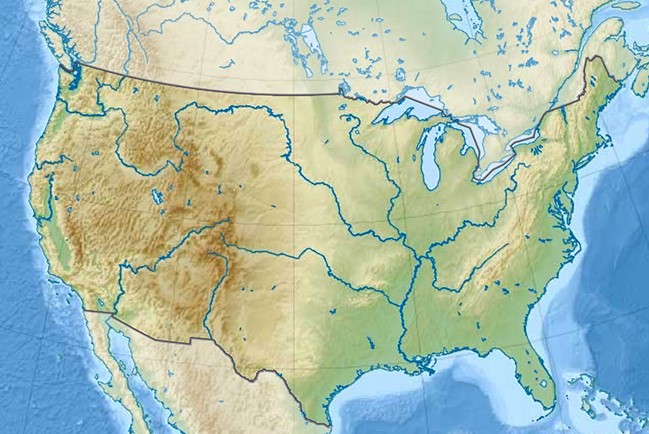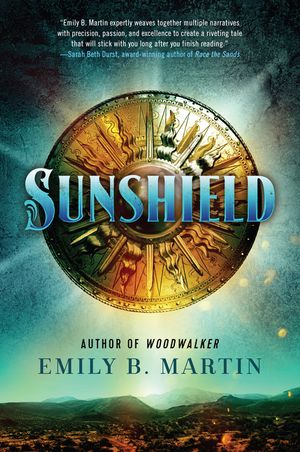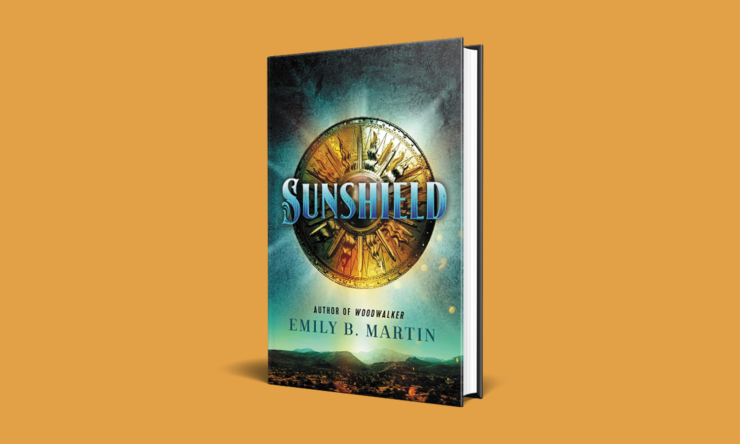In discussing Emily B Martin’s Sunshield, I think the best way for me to draw you into what the book is and what is doing is not to discuss the plot or characters, but instead to talk about worldbuilding in the novel, and the worldbuilding of a lot of fantasy worlds in general.
I’ve written about secondary world fantasy that is beyond the “Great Wall of Europe” before, specifically about “Silk Road Fantasy”, mainly focused on Africa and Asia. Instead of being just places for “The Other”, on the margins of a Europhilic fantasy, we’re getting more novels and stories where African and Asian cultures, peoples, and geographies are front and center.
Take a look at a lot of fantasy maps which have taken their cues from European geography and Tolkien’s Middle Earth, and you can see very familiar geographies and forms. The ocean is generally to the west. The north is cold and very mountainous. The south is warmer, home to older civilizations, and there is contact with the “Other” lands and peoples of jungle and desert. The east, when it is depicted, bleeds off into steppe and grassland. The heartland itself has navigable rivers, cities, pastoral bucolic farms and the other physiographic trappings of Medieval Europe. But there are so many other models that writers might use, and for that, come with me to a topographic map of North America.

The potentials for fantasy set in North America are vast and relatively untapped as fodder for secondary world fantasy. Far more common is a post-apocalyptic setting, where characters wander America’s blasted landscape. But fantasy might use the topographic ideas of North America effectively in unique and original worlds: Coastal mountains. Basin and Range desert. The Mississippi. The Great Lakes. Pacific Northwest style temperate rainforests. Great Plains. Florida style Everglades. Ancient eroded mountains. And in general, landscapes that have been, widescale, irrevocably changed by continental glaciation in very visible ways.
Emily B Martin’s Sunshield takes that potential and runs with it to create a canvas for her characters and story. The action takes place in two major locations, although others are mentioned and effect the story. First there is Moquoia, a realm inspired by the Pacific Northwest, a lush and often rainy temperate rainforest environment. Rainbows after rainstorms are of strong cultural importance to the Moquoians, and the use of colors as signifiers in clothing and epithets is inspired and clever worldbuilding. The rich and powerful Moquoia as setting helps sharpen the political maneuvering and machinations which dominate the narrative in the parts of the novel.
Buy the Book


Sunshield
The Ferinno desert, which lies to the southeast of Moquoia, evokes desert landscapes. There is careful and evocative description of the desert. I am not a student and resident of the desert and so I am not certain what kind of desert Martin is evoking here (Basin and Range, Mojave, Sonoran or Chihuahuan) but it is clear that the author has carefully crafted her landscape and how people engage and live within it. It’s a harsh land but for some, it is indeed a home. The striking contrast between it and the rich lands of Moquoia is something that you simply can’t get in a European based geography. The feel of the people and the settlements within the Ferinno also has a American frontier west sort of feel to the settlements as well.
There are other lands, seen in Martin’s previous novels, mentioned with some details—Cyprien feels like something like the bayou of Louisiana or the swamps of Florida, Lumen Lake akin to the Great Lakes, and the Silverwood Mountains with deciduous forests the landscapes of the Appalachians. The final map shows an overall landscape that does not resemble North America. However to my eye, the pieces and landscapes work together in a rational way. There are, fortunately, no eyesore river splits or unlikely mountain formations.Our characters are three. Lark is the titular Sunshield Bandit, raiding caravans and stagecoaches crossing the Ferinno desert (again, the use of stagecoaches helping to invoke that North American feel to the verse) , particularly focusing on attacking slave caravans and slavers. Her anger at them has a strong political focus, more than halfway to the point of obsession in trying to deal with the flow of human trafficking. Tamsin’s chapters are shorter and more mysterious—she is a prisoner, but why she is a prisoner and where she is, and the motivations behind it all are an engine of plot that slowly but surely ramps up as the novel builds. I was uncertain where Martin was going with Tamsin’s plotline at first, but in retrospect, see how the author built the throughline of her plot straight from the beginning. Veran is our third point of view. He is the junior member of an Ambassadorial team from the East visiting Moquoia,. Veran is the translator for the main team of Eloise and Rou. There is a succession crisis of sorts (although it is complicated and infused with the interesting culture Martin posits for the Moquoians) and foreign ambassadors seeking succor, even a junior one like Veran, gets caught up in the machinations of their hosts in short order.
All three of the main characters are well drawn with clear character arcs, even poor pent Tamsin, and with chances for growth and chance. They all have secrets hidden either from themselves, the reader or both. Veran is the son of a Queen, but there are intimations that he is not all that he himself wants to be or could be, but the exact reason is not made clear at the outset. Tamsin’s role and importance and discovering who she is and why she is important enough to be a prisoner is the entire part and parcel of her plotline. And then there is Lark. Sure, Lark is a bandit, raiding caravans, having forged a small found family of refugees and fellow bandits in a corner of the desert. But what drives her, really? Where did she really come from and wind up in this role? It’s firmly established that Lark’s own memories and past are not entirely clear to her. It’s a mystery to help pull the reader through her story, to unravel her secret and to see how the revelations will change her in the offing.
Martin does an excellent job with her plotlines and her split screen approach. I get the feeling that Lark and Tamsin’s stories, set in the desert, feels a little more natural and vibrant than the Moquoian courtly intrigue that Veran deals with, but both give ample opportunity for the author to explore the characters and their space. The characters feel like the landscapes they inhabit and also the landscapes that they originated in, which is not always the same thing. There is a consciousness of ecology and ecosystems that make the worlds feel alive. A small telling detail of showing the author’s interest in such matters, even in Moquoia amid the political plot, is when Veran discovers the high ecological cost of the glorious walls of glass in the Moquoian Palace. The three plotlines do turn out to be more related than at first glance, but the connections and linking up does not feel forced. Martin spends good time early in the novel in character comments, in small actions, and their drives in order to bring the three plotlines together quite effectively. The action beats are also effective and well written. While Lark’s plotline is the obvious source of action beats for the novel, Veran also gets into situations where he has to exchange politics for physical action.
In the end, as fine as the canvas that Martin has drawn here, it is the characters, and themes that are the abiding hallmarks of Sunshield. How the characters interact with each other and how they are part and parcel of the landscapes they inhabit are something I look forward to reading in more of Martin’s work. I am invested in learning more about her world and her core set of characters here, as well as those only mentioned off the page.
Sunshield is available from Harper Voyager.
An ex-pat New Yorker living in Minnesota, Paul Weimer has been reading sci-fi and fantasy for over 30 years. An avid and enthusiastic amateur photographer, blogger and podcaster, Paul primarily contributes to the Skiffy and Fanty Show as blogger and podcaster, and the SFF Audio podcast. If you’ve spent any time reading about SFF online, you’ve probably read one of his blog comments or tweets (he’s @PrinceJvstin).










